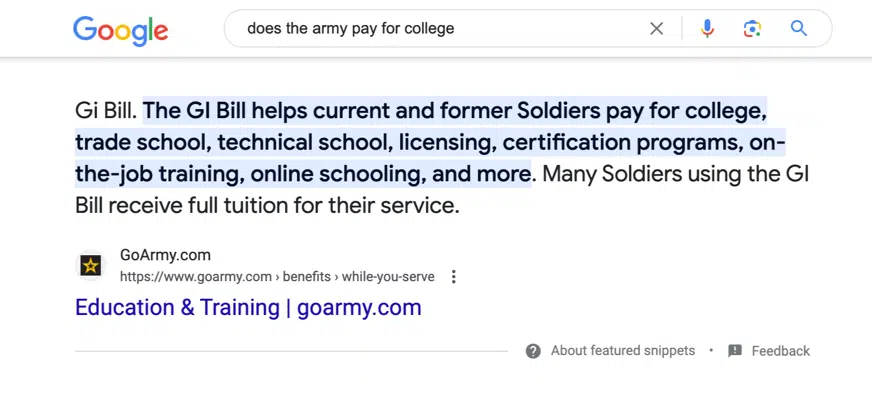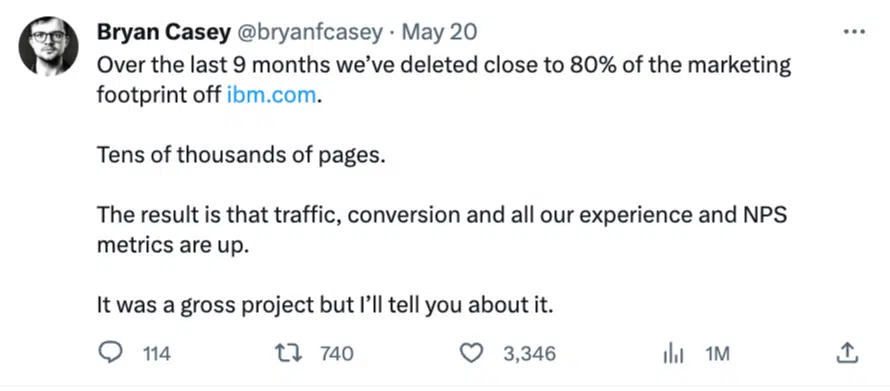This article was co-authored by Rebecca Steurer.
The world is drowning in digital content. Sadly, marketing success is often measured by quantity rather than the effectiveness of content in building awareness, generating leads, and converting customers.
As a result, we’ve turned the web into countless low-insight listicles that focus on capturing keyword searches instead of sharing insights that mean something to the reader.
Many digital experiences lack a content strategy that delivers the right information to the right audience at the right time. Rather, we have a free-for-all approach that produces content without direct value to the audience.
With the rise of ChatGPT and other generative AI tools, marketers will aggravate the issue by pumping out copious amounts of blog content to drive clicks.
However, that does nothing to help an audience thirsty for information.
Content overflow is sinking your ship
Clients are shocked when we advise them to reduce and consolidate their content footprint. The common response we get is, “But we can’t remove these landing pages because of SEO.”
We’re here to tell them, “You can! And you need to.”
Overwhelming your audience with content they don’t need will harm your site performance and bog down the capacity to be found.
Nearly 91% of content gets no traffic from Google. Part of this is due to limited ranking space – when millions of articles compete for the same audience and keywords, only a few will land at the top of search, while the rest sink into the abyss below page one of search results.
Bloated sites can also exhaust their crawl budget. A search engine like Google only crawls a certain amount of your website on each visit.
If your site is overloaded with content, there is a good chance that search engines will never find the best stuff you’ve created. Technical site issues like slow load speeds and bloated code can further squander your crawl budget.
Successful content consolidation: A case study
We saw this firsthand with our project for the U.S. Army recruiting website. Goarmy.com had not seen significant updates in over a decade, including SEO strategy.
The site was built around dated SEO principles of creating a separate page for each keyword rather than deep pages that covered topics in depth.
This, combined with a tendency to use the site as a “dumping ground” for content from various constituencies, led to a site with over 10,000 pages that provided little information about joining the Army.
The site captured only 19% of potential top-three keyword rankings and an insignificant percentage of featured snippets.
Bottom line: Google didn’t see goarmy.com as a good source of information about the brand.
Part of this was content quality, and part was an inability to locate some content at all.
Bloated taxonomy, lack of sitemaps, non-responsive pages and slow page loads created a situation where search crawlers couldn’t even find valuable pages on the site, leaving ample content that had never been crawled or indexed.
We created an SEO and content strategy that changed all that.
Step 1: Proof of concept tests
We ran “proof of concept” tests, adding FAQs and schema to select pages, speeding pages up with AMP and testing consolidated content and responsive pages.
Even the smallest changes delivered tremendous results, convincing the client to sign off on a revamp.
Search data and website analytics helped us recognize content resonating with target audiences and the gaps we needed to fill.
We realized that some content, like pages about weapons and vehicles, drew in traffic but did not convert.
This content appealed to military fans, not those interested in joining. Just drawing traffic was not enough – anything that did not advance the mission had to go.
Step 2: Content consolidation plan
We began consolidating “thin” content into information-rich pages that thoroughly covered each facet of joining the Army and fully answered prospects’ questions about the process.
This project reduced the site by 95%, down to 445 URLs. This causes some consternation to clients, as they fear that less is less and that they will lose traffic and rankings by eliminating pages.
Instead, the opposite was true. As we consolidated pages and prioritized content that Remember answered user questions, Google began to recognize GoArmy as an expert on the Army brand.
This was shown in a 295% increase in captured answer boxes, from 994 to 3,724, in one year. The content on GoArmy is now more findable on Google and has increased keywords in the top three positions by 115%, from 9,160 to 19,732.
Most importantly, the slimmed-down site drives more traffic and conversions: organic visits have increased 31% FYTD, and primary conversions have increased 78% YoY FYTD.

Through a less-is-more strategy, we focused the Army on the content that matters to their prospects and created a recruiting website that performs beyond all expectations.
Another example in action
The Army website is just one example of this principle. Bryan Casey, Director of Digital at IBM, detailed his company’s project to reduce website bloat on X.

The story was similar to the Army’s: The IBM site had become an organizational structure disguised as a website – full of content that internal audiences want but may hold little to no customer interest.
As Casey noted on Twitter:
- “The site was impossible to manage for our teams and too hard to understand and use for our customers.”
The team used data to show content that resonated with users and used the findings to create buy-in across teams to remove any content that was not essential to the customer journey.
The key was reminding internal stakeholders that the overloaded website was actually harming everyone’s traffic. This is a team project that will require sacrifice from each group, but that will create a greater payoff for all stakeholders moving forward.
- “We consolidated everything we could. We had places where we had three pages that could reasonably target the same keyword. Now we have one,” Casey wrote.
Like the Army project, IBM’s massive reduction of pages increased traffic and conversions.
Google demands quality
Google recognizes the issue of content overload and has started striking out at low-value content with the helpful content update, which prioritizes content that meets E-E-A-T guidelines, where producing quality content takes priority over quantity.
Google’s recent addition of “experience” as a part of good content adds a guideline that an AI chatbot cannot bring to the table since they still cannot experience our world.
Content from a knowledgeable author who has a point of view and writes verifiable facts will rise as repetitive listicles with nothing new to say.
In short, Google is telling you to slow down your content generation machine. Focus on creating content of value that only your brand and your expert are uniquely equipped to provide.
Get the daily newsletter search marketers rely on.
Key tips to create an audience-focused website
Some lessons here can help you create a leaner website that is more attuned to the needs of your audience.
Know your niche
Know exactly who you want to reach with your content – and don’t say “everybody!” Google is looking for websites with expertise in a particular topic or field.
Run each potential piece of content by this content mission equation:
- Our website is where (audience A) gets (content B) to (achieve C).
If your content doesn’t fit that mission statement, it doesn't fit in your niche.
Consolidate and eliminate
Look for opportunities to combine content on a similar topic into one larger page. Multiple short pages on a topic can split up traffic and link equity, which are search ranking signals.
Combining content consolidates links and traffic and improves the likelihood of capturing more high keyword rankings. The average length of a top 10 Google result is 1,447 words.
The word count does not affect the ranking. It's because longer, more in-depth content typically covers a topic fully, uses more keywords and answers more customer queries.
Be aware of your customer’s goals and eliminate content that does not help.
Make the criteria and goals of content elimination clear to internal stakeholders so everyone understands why their content may be removed.
Be firm, be decisive – when in doubt, cut.
Dig deeper: Improving or removing content for SEO: How to do it the right way
Provide value
The first rule of value is that content on your website is aimed at the customer and their needs.
That means eliminating ego-driven content – those that fill the needs of someone in the organization but not the customer.
Every internal constituency does not need to be represented on your website. The site and its content should relentlessly focus on helping the customer achieve an informational or transactional goal.
The second rule of value is to provide something customers can’t get anywhere else.
In the case of a financial website, “Five Ways to Save for College” is a low-value content proposition. These simple listicles can be found on any financial website and will provide virtually identical information.
Real value lies in original content that has an insightful point of view. This can include original research or thoughts on a subject that only an expert can provide.
Instead of “Five Ways to Save for Retirement”, a more original and insightful topic might be “Best Retirement Investments During a Recession,” where a financial expert can provide an original spin on a worn topic.
Eliminate the editorial calendar
That doesn’t mean you shouldn’t plan out your content. It means eliminating content quantity as a goal.
When we set out with a goal like “create 20 articles a month,” we create content that fills a quota rather than a need.
Reduce the amount of content produced and focus on longer, more in-depth content that covers a topic completely. Focus on performance (traffic, links, shares, email signups) over production.
Remember why we’re here
We are still content marketers. Content must have a clear connection to the customer.
With so many low-quality information options available, we must create quality content that rises above that is informative, thorough, original and helps fill a unique client need.
People are thirsty for information. Let’s not drown them in it.
Dig deeper: How content consolidation can improve your SEO performance
Opinions expressed in this article are those of the guest author and not necessarily Search Engine Land. Staff authors are listed here.
Related stories
New on Search Engine Land
"strategy" - Google News
November 15, 2023 at 06:00PM
https://ift.tt/rXx3RHJ
Content strategy: Why less is more - Search Engine Land
"strategy" - Google News
https://ift.tt/xncGwSV
https://ift.tt/mx79Jth
Bagikan Berita Ini














0 Response to "Content strategy: Why less is more - Search Engine Land"
Post a Comment